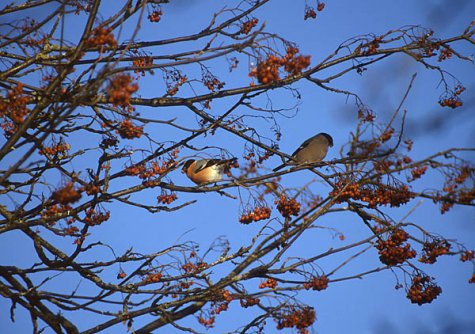Bullfinches light up late autumn
Photo: Arne Ader
Translation: Liis
Bullfinch pair in rowan
Bullfinch Leevike Pyrrhula pyrrhula
Bullfinches passing on migration could be seen on Sunday on the north-western coast. They move mainly in small groups, more seldom in flocks of a hundred birds. A part of the birds that nested here have migrated to nearby southerly areas; they have been replaced by the arrived and still arriving nesters from north and north-east.
Bullfinches are quite big and portly birds. About the plumage: the head and tail are black, back plumage grey, rump area bright white. A rather broad pale grey band runs across the black wings, it can be seen both in flight and on a bird sitting in a tree. We recognize the male from postcards, from its „bullfinch red“ underparts, the back plumage is grey but with rose-coloured shades. The underparts of the female have a pink hue, the grey back plumage is tinged in brown. The plumage of female birds and of young birds are similar but the young birds don’t have a black head yet; it is brownish instead. Quite easy to tell apart.
On Sunday the birds in the migrant flocks were busy in the border area between forest and cultural landscape; there is still plenty of weed seeds but the birds stay only briefly on the ground, there is no control of the surroundings and they dislike that. On rowans and other trees or shrubs where fruits still remain only the seeds are eaten, the fruit pulp is spilled out. We have noticed such unkempt dinner tables under rowans.









